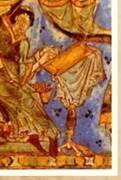Презентація: 'The Anglo-Saxons'
BRITAIN in the EARLY MIDDLE AGES
THE MAIN BOOK OF THE MIDDLE AGES IS THE BIBLE [THE OLD AND NEW TESTAMENTS]
OlliXlhll
Gil
PHOTO: THE BOOK OF KELLS
THE OLD ENGLISH PERIODIV—XI CENTURIES
BRITAIN
IN THE EARLY MIDDLE AGES
The fall of the Western Roman Empire, the largest slave-owning state in the ancient world, is regarded as the end of the ancient world.
The historical period between ancient and modern times is called the Middle Ages.
The Middle Ages lasted for twelve centuries, since the end of the ancient world in the latter half of the 5th century till the beginning of modern history in the middle of the 1 7th century.
Slavery predominated in the ancient states.
In the Early Middle Ages a new social system — feudalism — gradually was established ![]() and at last became predominant in Britain.
and at last became predominant in Britain.
It took six centuries for the new social system to become predominant in Western Europe.
THE GERMANIC TRIBES
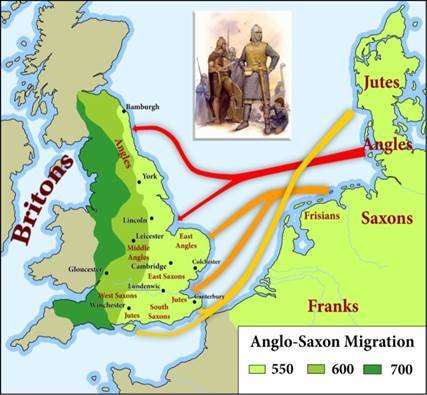 The Romans protected their province of Britain against the barbarian tribes until they left which was at the beginning of the 5th century. In the middle of the 5th century the Anglo-Saxons, Germanic tribes, invaded Britain. The Anglo-Saxon conquest is regarded as the beginning of medieval history in Britain. The Anglo-Saxon were the ancestors of the English. As a result of the conquest they formed the majority of the population in Britain.
The Romans protected their province of Britain against the barbarian tribes until they left which was at the beginning of the 5th century. In the middle of the 5th century the Anglo-Saxons, Germanic tribes, invaded Britain. The Anglo-Saxon conquest is regarded as the beginning of medieval history in Britain. The Anglo-Saxon were the ancestors of the English. As a result of the conquest they formed the majority of the population in Britain.
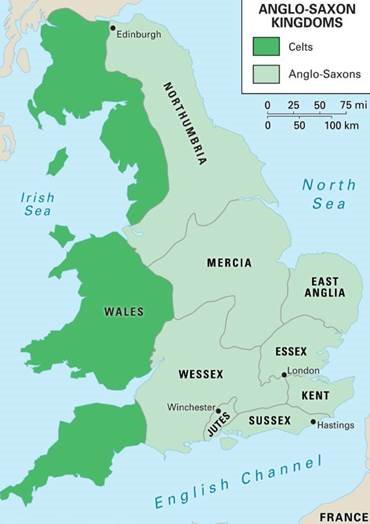
![]() ANGLO-SAXON
ANGLO-SAXON
HEPTARCHY*
The Anglo-Saxon settlement of Britain is the process which changed the language and culture of most of what became England from Romano-British to Germanic. The Germanic-speakers in Britain, themselves of diverse origins, eventually developed a common cultural identity as Anglo-Saxons.
This process occurred from the mid-fifth to early seventh centuries, following the end of Roman rule in Britain around the year 410 A.D. The settlement was followed by the establishment of the Heptarchy, Anglo-Saxon kingdoms in the south and east of Britain, later followed by the rest of modern England, and the south-west of modern Scotland.
Heptarchy ['hepta:rki] — cTpaHa, ynpaBJIReMa9 ceMblO nmqaMV1; ceMVlBnacTme.
PAGAN GODS
All the Germanic tribes were pagans as they lived under the primitive system; they believed in many gods. One of the Anglo-Saxons' gods was Tuesco — the god of Darkness, another was
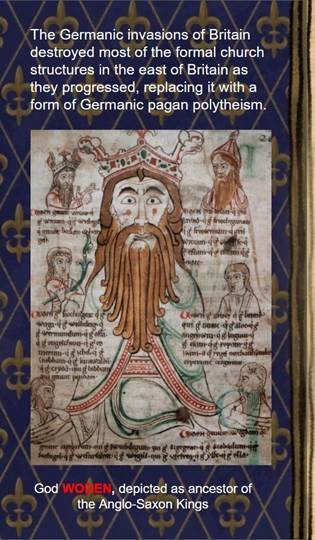 Woden — the great god of War; the red-bearded Thor was the god of Thunder; the goddess of Peace and Plenty was Freya. They also worshipped the sun, the moon and other heavenly bodies.
Woden — the great god of War; the red-bearded Thor was the god of Thunder; the goddess of Peace and Plenty was Freya. They also worshipped the sun, the moon and other heavenly bodies.
The Anglo-Saxons named the days of the week after their gods. Thus Sunday means the Sun's day, Monday — the Moon's day, Tuesday — the day of the god
Tuesco; Wednesday was Woden's day, Thursday was Thor's day and Friday — Freya's day; Saturday was named after Saturn, a Roman God.
In 597 the Roman Pope sent about forty monks to Britain to convert the Anglo-Saxons. The monks landed in Kent and it became the first kingdom to be converted. The first church was built in the town of Canterbury, the capital of Kent, that is why the Archbishop of Canterbury is now Head of the Church of England. Then Christianity spread among the other kingdoms of Heptarchy.
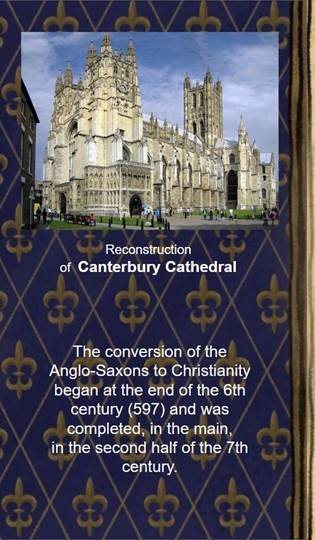 Conversion of the Anglo-Saxons to
Conversion of the Anglo-Saxons to
CHRISTIANITY
The spread of Christianity was a great importance for the growth of culture in Britain. The Roman monks helped to spread Roman culture in the country again; they brought many books written in Latin and Greek. The church services were also conducted in Latin because it was of international importance of that time, and used by learned men in all countries, as English now.![]()
MONKS & MONASTERIES
The Anglo-Saxon nobles were ignorant, many of them were quite illiterate and could not even sign their names. No one except the monks knew Latin and the monasteries became centres of knowledge and of learning in those early times. The monks copied out many handwritten books and even translated some books from Latin and Greek to Anglo-Saxon.
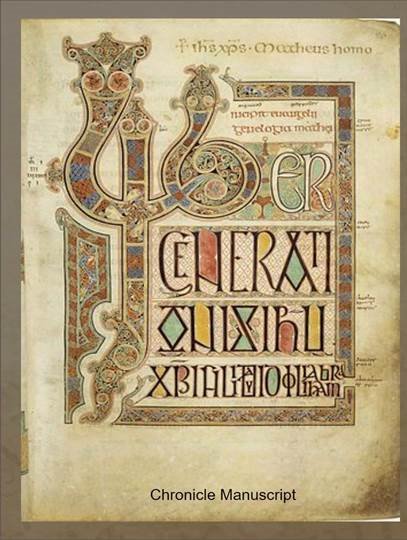 Some monks were chroniclers — they kept a record of the important events of each year. Psalters, chronicles and other manuscripts written by the medieval monks are very important historical documents today. Monks often illuminated their manuscripts with the miniatures and drawings which are also of great interest for they portray many things of contemporary life.
Some monks were chroniclers — they kept a record of the important events of each year. Psalters, chronicles and other manuscripts written by the medieval monks are very important historical documents today. Monks often illuminated their manuscripts with the miniatures and drawings which are also of great interest for they portray many things of contemporary life.
The most famous early-medieval writers were the monk Bede (673—735) and the scholar Alcuin (735—804). Both were of Anglo-Saxon origin from the kingdom of Northumbria.
|
|
• |
|
|
|
|
|
e E NGU 1 N CLASSICS BEDE |
|
ECCLESIASTICAL HISTORY OF 'IMF. ENGLISH PEOPLE |
|
|
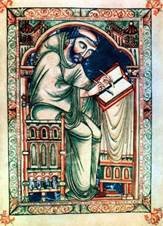



 EARLY-MEDIEVAL WRITERS
EARLY-MEDIEVAL WRITERS
The Venerable Bede wrote Ecclesiastical History of the English People; it was studied carefully by educated people in Europe as it was the only book on Anglo-Saxon history of that time. From this book we learn much of what happened in Britain thirteen centuries ago. A copy of the Bede's book can be found in the British museum in London.
The Venerable Bede Another author of the school text-books that AOCTonOHTeHHblV1 6éna were very popular in the 8th—9th centuries not only in England but on the continent too was the monk Alcuin. As a teacher he became famous all over England. Many young monks would come to the school in York from far away places to be taught by Alcuin. Later, for more than twenty years Alcuin lived on the Continent where he organized monastic schools and many pupils of his became well-known teachers.
Thus the spread of Christianity promoted a ![]() revival of learning and had a tremendous
revival of learning and had a tremendous ![]() influence over men's minds and actions. Ecclesiastical A page History of Bede's of the English book people
influence over men's minds and actions. Ecclesiastical A page History of Bede's of the English book people
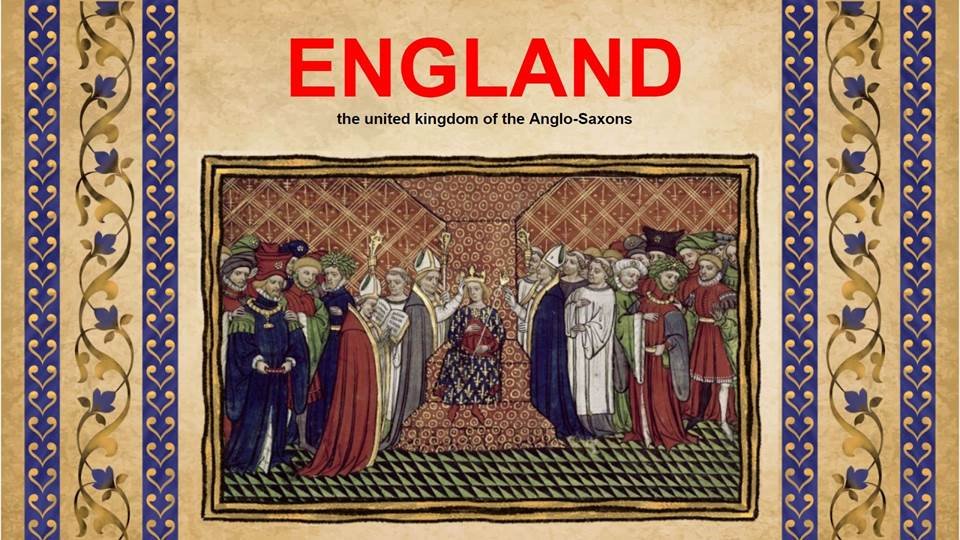
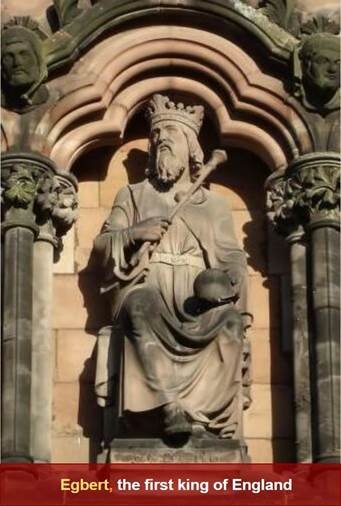 For three centuries a struggle went on between the little Anglo-Saxon kingdoms set up in the 5th—6th centuries. As feudal relations develop the owners of the big landed estates strive to unify the separate kingdoms into one state under the power of one king.
For three centuries a struggle went on between the little Anglo-Saxon kingdoms set up in the 5th—6th centuries. As feudal relations develop the owners of the big landed estates strive to unify the separate kingdoms into one state under the power of one king.
At the end of the 8th century another branch of Germanic people begins to attack Britain. The separate Anglo-Saxon kingdoms fighting among themselves become an easy prey for the invaders. The 9th century sees the political unification of the Anglo-Saxon kingdoms.
![]() 829 Egbert, King of Wessex, was acknowledged by Kent, Mercia and Northumbria. This was really the beginning of the united kingdom of England, for Wessex never again lost its supremacy and King Egbert became the first king of England. Under his rule all the small Anglo-Saxon kingdoms were united to form one kingdom which was called England from that time on.
829 Egbert, King of Wessex, was acknowledged by Kent, Mercia and Northumbria. This was really the beginning of the united kingdom of England, for Wessex never again lost its supremacy and King Egbert became the first king of England. Under his rule all the small Anglo-Saxon kingdoms were united to form one kingdom which was called England from that time on.
![]()
THE DANES — INVADERS
![]()
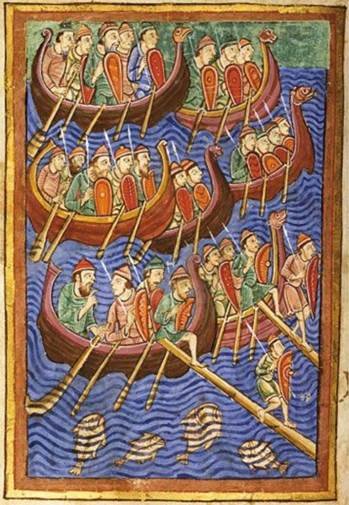 The political unification of the Anglo-Saxon kingdoms was sped up by the urgent task of defending the country against the dangerous raids of the new enemies. Since the end of the 8th century until the end of the 10th century Britain was troubled by a new wave of barbarian attacks. These barbarians came from the North from Norway and Denmark, and were called Northmen (the Vikings, the Danes).
The political unification of the Anglo-Saxon kingdoms was sped up by the urgent task of defending the country against the dangerous raids of the new enemies. Since the end of the 8th century until the end of the 10th century Britain was troubled by a new wave of barbarian attacks. These barbarians came from the North from Norway and Denmark, and were called Northmen (the Vikings, the Danes).
The Danes were well-armed; their ships were sailing boats provided with oars. Their earliest raids were for plunder only: they came in spring and summer, and when the ships were loaded with plunder they returned home for the winter. In later years large Danish fleets (more than three hundred ships) brought large armies to conquer and settle in the new lands. From their camps the Danes would make many raids upon the villages and towns in the area. The Danish raids were successful because the kingdom of England had neither a regular army nor a fleet in the North Sea to meet them.
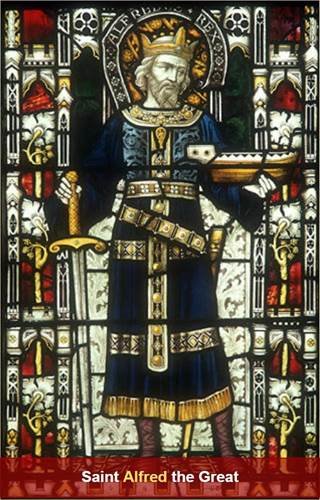 First, Northumbria and East Anglia suffered most from the Danish raids. At last, all England north of the Thames, that is, Northumbria, Mercia and East Anglia, was in their hands. Only Wessex was left to face the enemy.
First, Northumbria and East Anglia suffered most from the Danish raids. At last, all England north of the Thames, that is, Northumbria, Mercia and East Anglia, was in their hands. Only Wessex was left to face the enemy.
Wessex under the reign of Egbert's grandson, King Alfred (871—899), who was known in English history as Alfred the Great, became the centre of resistance against the invaders. During the reign of Alfred the Great the first British Navy was built and a war fleet of ships large and faster of those of the Danes protected the island. As a result of these measures, the Anglo-Saxons won several victories over the Danes.
At the end of the 9th century new Danish attacks were made, but they were bitten off; the Anglo-Saxons won their first victories on the sea, and soon the Danes no longer dared to attack Wessex.
The Anglo-Saxon Chronicle
In the time of peace Alfred the Great took measures to improve the laws and the standards of culture among the Anglo-Saxons. He ordered all future state officials and all the priests to learn the Latin language, as the Bible and service-books were all in that language, and it was the duty of the clergy to understand them.
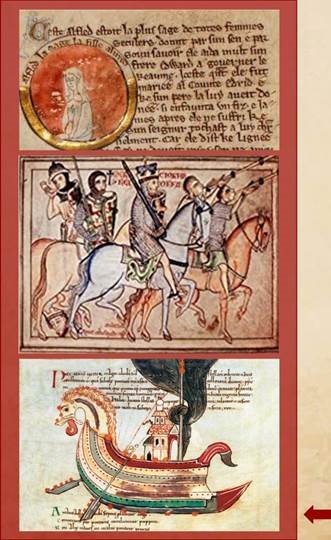 As nearly all the books of that time were written in Latin, a few people could read them, translations of some Latin books into Anglo-Saxon were made. Books on religion, history and philosophy were translated so that those people who learned to read could understand them in their own tongue. Some books were translated from Latin by King Alfred himself. Among others, he translated Ecclesiastical History of the English People which the Venerable Bede had written in Latin. Then Alfred ordered that the learned men should begin to write a history of England.
As nearly all the books of that time were written in Latin, a few people could read them, translations of some Latin books into Anglo-Saxon were made. Books on religion, history and philosophy were translated so that those people who learned to read could understand them in their own tongue. Some books were translated from Latin by King Alfred himself. Among others, he translated Ecclesiastical History of the English People which the Venerable Bede had written in Latin. Then Alfred ordered that the learned men should begin to write a history of England.
In several monasteries the learned monks collected together all that was known of the early history of the country and began to keep a record of the outstanding events of each year. Thus was written a history of England called the Anglo-Saxon Chronicle which was continued for 250 years after the death of Alfred.
Pages from the Anglo-Saxon Chronicles
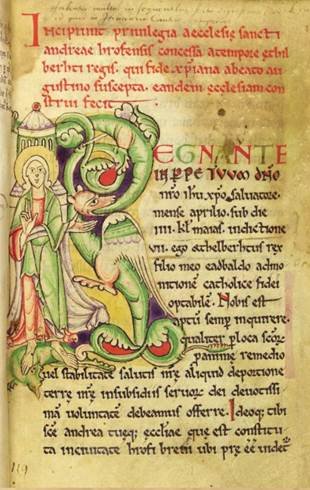
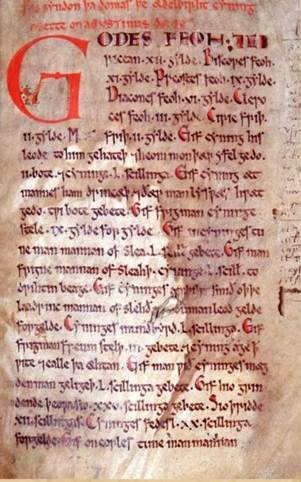 CODE of LAW
CODE of LAW
King Alfred also ordered that the old customs and laws followed by the Anglo-Saxons before him in Wessex and Mercia should be collected. New laws were added to the collection, and the Code of English Law was drawn up.
Everybody had to follow the laws of the kingdom. In the reign of Alfred the Great the power of the loyal officials strengthened greatly. The whole country was divided into shires and hundreds as before and through his officials King Alfred held all parts of the country under strict control.
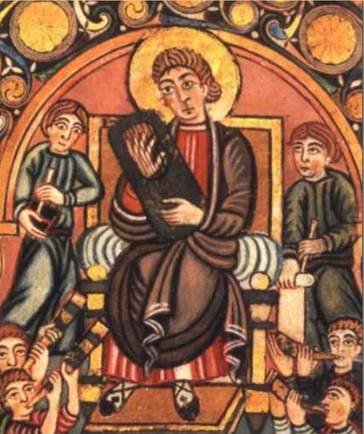 ANGLO-SAXON POETRY
ANGLO-SAXON POETRY
English literature began with oral songs and heroic poems, which were passed on by minstrels, and scops, who also composed poems of their own and sang them to a harp accompaniment. In this way common people learned of the major battles and the tribe's heroes.
All of the earliest English literature is found in four manuscripts written down by monks probably in the 10th century and their poems go back to the 7th and 8th centuries: the Bodleian manuscript of biblical poems; the Exeter manuscript, which includes the advent and love lyrics, as well as collections of aphorisms, elegies and riddles; the Vercelli manuscript containing The Dream of the Rood. It is a short religious poem which describes a vision of the cross, covered both in blood and jewels, a vision of Christ's Crucifixion, and promises a final triumph to the miserable narrator.
The most important Anglo-Saxon poetic work is in the Beowulf manuscript, which contains an epic poem, telling the story of a Danish hero who saves the neighbouring people
from a terrible monster.
Anglo-Saxon scops and minstrels
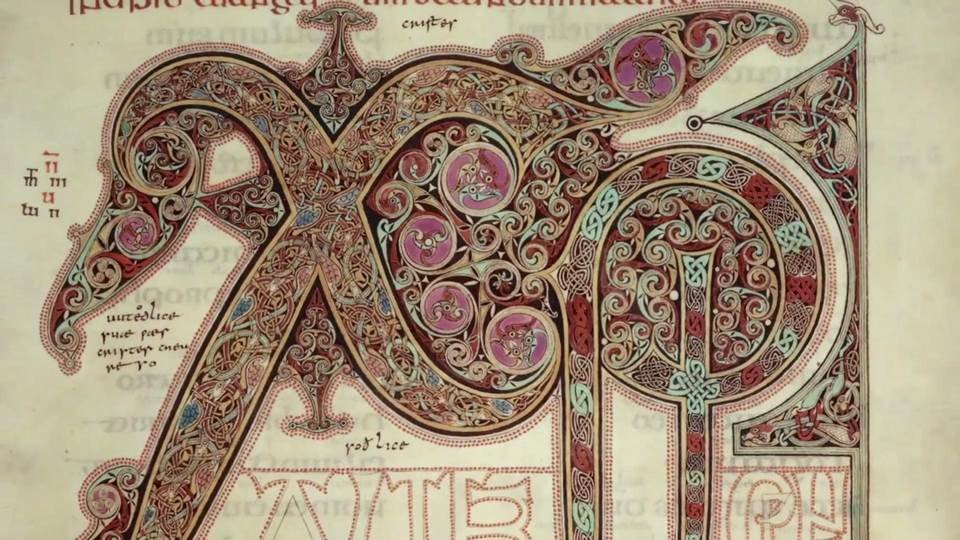
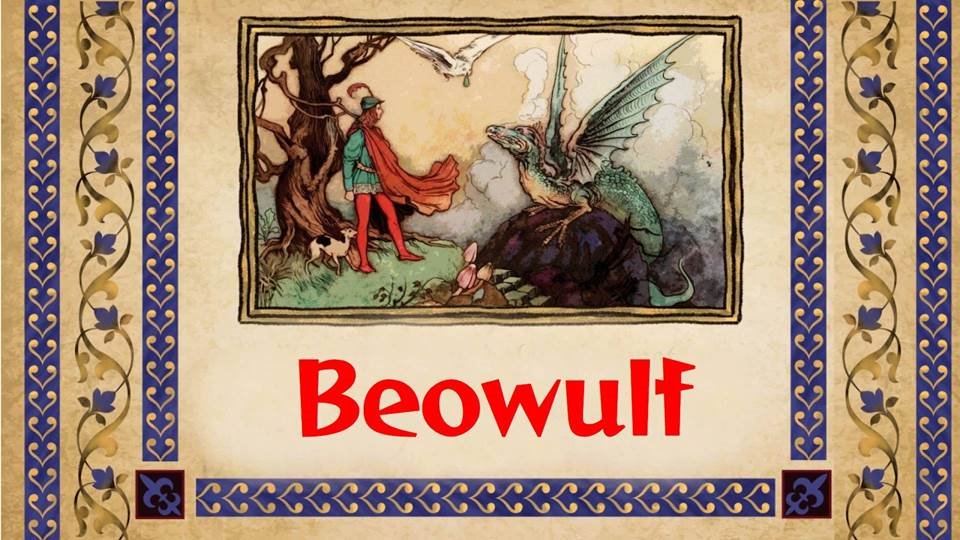
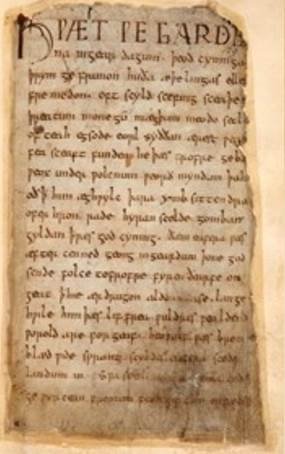
The Beowulf Manuscript
The famous Anglo-Saxon legend about the great warrior, Beowulf, was handed down orally long before it was written down by a monk.
![]() The manuscript named Beowulf after the great legendary warrior is the longest heroic epic poem in Old English (the language spoken in Anglo-Saxon England before the Norman Conquest in 1066). It is the highest achievement of Old English literature. It tells us about the life of Anglo-Saxons on their native lands in Denmark at the time when every man was a warrior. The poem describes the arms and armour of the Anglo-Saxon warriors, their exploits and adventures. The military leaders of the powerful tribes are called kings in the poem. Beowulf relates the exploits of its eponymous hero and his successive battles with a monster named Grendel, with Grendel's revengeful mother, and with a dragon which was guarding a hoard of treasure. The poem recreats for us those ancient times when men lived roughly but nobly, and when heroes feared no one but huge creatures such as demons and dragons.
The manuscript named Beowulf after the great legendary warrior is the longest heroic epic poem in Old English (the language spoken in Anglo-Saxon England before the Norman Conquest in 1066). It is the highest achievement of Old English literature. It tells us about the life of Anglo-Saxons on their native lands in Denmark at the time when every man was a warrior. The poem describes the arms and armour of the Anglo-Saxon warriors, their exploits and adventures. The military leaders of the powerful tribes are called kings in the poem. Beowulf relates the exploits of its eponymous hero and his successive battles with a monster named Grendel, with Grendel's revengeful mother, and with a dragon which was guarding a hoard of treasure. The poem recreats for us those ancient times when men lived roughly but nobly, and when heroes feared no one but huge creatures such as demons and dragons.
Beowulf survives in a single medieval manuscript. The manuscript bears no date, and so its age has to be calculated by analyzing the scribes' handwriting. Scholars have suggested that the manuscript was made in about 1000 A.D.
At the beginning of the 11th century England was conquered by the Danes once more.
The Danish king Canute (1017—1035) became king of Denmark, Norway and England.

 He made England the center of his power.
He made England the center of his power.
So for some period in the 11th century England came under the power of the Danish kings.
Under both Anglo-Saxon and Danish kings feudal society continued to develop in England.
Part I . From the Germanic tribes to Anglo-Saxons
Questions for discussion:
1 . How did the Jutes, Saxons and Angles live before their migration to Britain?
2. Why did it take more that one hundred and fifty years for the Germanic tribes to conquer Britain?
3. What does 'heptarchy' mean? Name the Anglo-Saxon kingdoms on the British Isles?
4. What did the English names of the days of the week mean in early times? Who was the forefather of Old English kings?
5. Who are the Welsh? 1m what other parts of Britain are there Celtic-speaking people living today?
6. Why did the conversion of the Anglo-Saxons to Christianity take place in the 7th century but not earlier? Why was it that the Anglo-Saxons kings and nobles accepted Christianity first?
7. How did the conversion of the Anglo-Saxons to Christianity influence the cultural development of Britain?
a) Cite facts to show that the monasteries in Anglo-Saxon times were centres of knowledge and learning.
b) Who was Bede? c) Who was Alcuin?
8. How many manuscripts in Old English are there? What are they about?
Questions on the poems:
9. Why does Old English literature maintain a dignified and grim mood?
10. Which manuscripts contain Old English literature?
1 1 . From what source do we learn about Great Britain before the Anglo-Saxon invasion?
12. When was the Beowulf poem written? What events does it refer to? Who is the author of the poem?


про публікацію авторської розробки
Додати розробку


